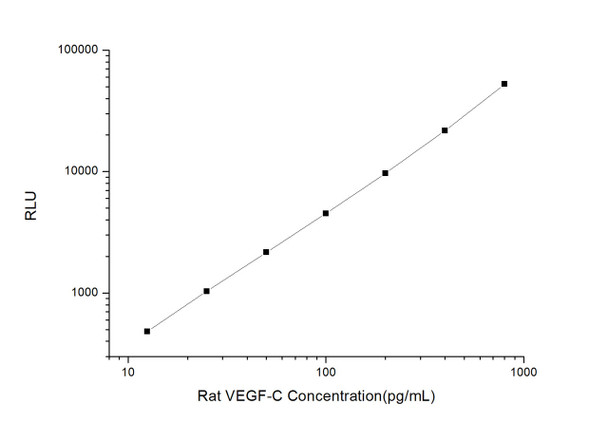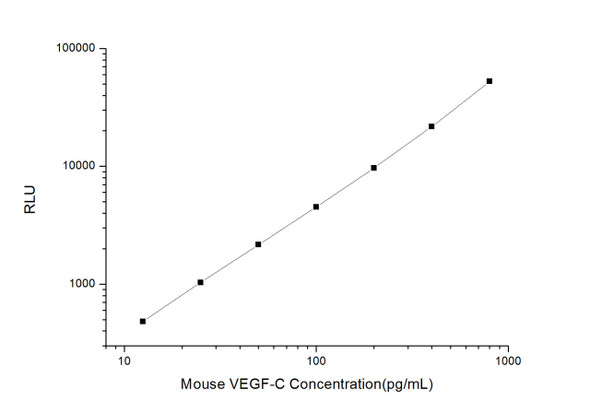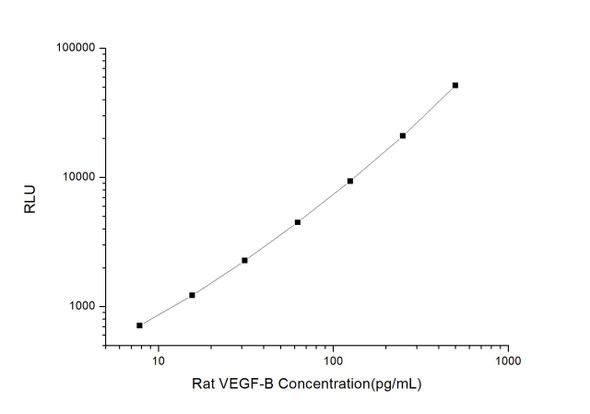Rat Signaling ELISA Kits 3
Rat VEGF-C (Vascular Endothelial Cell Growth Factor C) CLIA Kit (RTES00588)
- SKU:
- RTES00588
- Product Type:
- ELISA Kit
- ELISA Type:
- CLIA Kit
- Size:
- 96 Assays
- Sensitivity:
- 7.5pg/mL
- Range:
- 12.5-800pg/mL
- ELISA Type:
- Sandwich
- Synonyms:
- VEGFC, Flt4-L, VRP
- Reactivity:
- Rat
- Sample Type:
- Serum, plasma and other biological fluids
- Research Area:
- Cardiovascular
Description
| Assay type: | Sandwich |
| Format: | 96T |
| Assay time: | 4.5h |
| Reactivity: | Rat |
| Detection method: | Chemiluminescence |
| Detection range: | 12.50-800 pg/mL |
| Sensitivity: | 7.50 pg/mL |
| Sample volume: | 100µL |
| Sample type: | Serum, plasma and other biological fluids |
| Repeatability: | CV < 15% |
| Specificity: | This kit recognizes Rat VEGF-C in samples. No significant cross-reactivity or interference between Rat VEGF-C and analogues was observed. |
This kit uses Sandwich-CLIA as the method. The micro CLIA plate provided in this kit has been pre-coated with an antibody specific to Rat VEGF-C. Standards or samples are added to the appropriate micro CLIA plate wells and combined with the specific antibody. Then a biotinylated detection antibody specific for Rat VEGF-C and Avidin-Horseradish Peroxidase (HRP) conjugate are added to each micro plate well successively and incubated. Free components are washed away. The substrate solution is added to each well. Only those wells that contain Rat VEGF-C, biotinylated detection antibody and Avidin-HRP conjugate will appear fluorescence. The Relative light unit (RLU) value is measured spectrophotometrically by the Chemiluminescence immunoassay analyzer. The RLU value is positively associated with the concentration of Rat VEGF-C. The concentration of Rat VEGF-C in the samples can be calculated by comparing the RLU of the samples to the standard curve.
| UniProt Protein Function: | VEGFC: Growth factor active in angiogenesis, and endothelial cell growth, stimulating their proliferation and migration and also has effects on the permeability of blood vessels. May function in angiogenesis of the venous and lymphatic vascular systems during embryogenesis, and also in the maintenance of differentiated lymphatic endothelium in adults. Binds and activates VEGFR-2 (KDR/FLK1) and VEGFR-3 (FLT4) receptors. Homodimer; non-covalent and antiparallel. Spleen, lymph node, thymus, appendix, bone marrow, heart, placenta, ovary, skeletal muscle, prostate, testis, colon and small intestine and fetal liver, lung and kidney, but not in peripheral blood lymphocyte. Belongs to the PDGF/VEGF growth factor family. |
| UniProt Protein Details: | Protein type:Cytokine; Motility/polarity/chemotaxis; Cell cycle regulation; Secreted; Secreted, signal peptide Cellular Component: extracellular space; membrane Molecular Function:growth factor activity; vascular endothelial growth factor receptor 3 binding; chemoattractant activity Biological Process: response to drug; positive regulation of neuroblast proliferation; positive regulation of blood vessel endothelial cell migration; regulation of angiogenesis; positive regulation of protein amino acid autophosphorylation; induction of positive chemotaxis; negative regulation of cell proliferation; positive regulation of peptidyl-tyrosine phosphorylation; positive regulation of angiogenesis; organ morphogenesis; morphogenesis of embryonic epithelium; positive regulation of protein secretion; positive chemotaxis; regulation of vascular endothelial growth factor receptor signaling pathway; positive regulation of cell division; positive regulation of cell proliferation; negative regulation of blood pressure; angiogenesis; positive regulation of cell-matrix adhesion; vascular endothelial growth factor receptor signaling pathway; positive regulation of epithelial cell proliferation |
| NCBI Summary: | platelet-derived growth factor/vascular derived growth factor (PDGF/VEGF); active in angiogenesis and endothelial cell growth [RGD, Feb 2006] |
| UniProt Code: | O35757 |
| NCBI GenInfo Identifier: | 16758992 |
| NCBI Gene ID: | 114111 |
| NCBI Accession: | NP_446105. 1 |
| UniProt Secondary Accession: | O35757,Q91ZE3, |
| UniProt Related Accession: | O35757 |
| Molecular Weight: | 46,397 Da |
| NCBI Full Name: | vascular endothelial growth factor C |
| NCBI Synonym Full Names: | vascular endothelial growth factor C |
| NCBI Official Symbol: | Vegfc |
| NCBI Protein Information: | vascular endothelial growth factor C |
| UniProt Protein Name: | Vascular endothelial growth factor C |
| UniProt Synonym Protein Names: | Flt4 ligand; Flt4-L; Vascular endothelial growth factor-related protein; VRP |
| Protein Family: | Vascular endothelial growth factor |
| UniProt Gene Name: | Vegfc |
| UniProt Entry Name: | VEGFC_RAT |
As the RLU values of the standard curve may vary according to the conditions of the actual assay performance (e. g. operator, pipetting technique, washing technique or temperature effects), the operator should establish a standard curve for each test. Typical standard curve and data is provided below for reference only.
| Concentration (pg/mL) | RLU | Average | Corrected |
| 800 | 51012 54272 | 52642 | 52616 |
| 400 | 21478 21990 | 21734 | 21708 |
| 200 | 9795 9621 | 9708 | 9682 |
| 100 | 4406 4698 | 4552 | 4526 |
| 50 | 2324 2052 | 2188 | 2162 |
| 25 | 1083 1037 | 1060 | 1034 |
| 12.50 | 475 543 | 509 | 483 |
| 0 | 26 26 | 26 | -- |
Precision
Intra-assay Precision (Precision within an assay): 3 samples with low, mid range and high level Rat VEGF-C were tested 20 times on one plate, respectively.
Inter-assay Precision (Precision between assays): 3 samples with low, mid range and high level Rat VEGF-C were tested on 3 different plates, 20 replicates in each plate.
| Intra-assay Precision | Inter-assay Precision | |||||
| Sample | 1 | 2 | 3 | 1 | 2 | 3 |
| n | 20 | 20 | 20 | 20 | 20 | 20 |
| Mean (pg/mL) | 42.52 | 104.37 | 276.29 | 43.25 | 105.12 | 290.10 |
| Standard deviation | 4.36 | 12.32 | 24.56 | 4.75 | 10.54 | 19.76 |
| C V (%) | 10.25 | 11.80 | 8.89 | 10.98 | 10.03 | 6.81 |
Recovery
The recovery of Rat VEGF-C spiked at three different levels in samples throughout the range of the assay was evaluated in various matrices.
| Sample Type | Range (%) | Average Recovery (%) |
| Serum (n=5) | 85-98 | 92 |
| EDTA plasma (n=5) | 94-106 | 100 |
| Cell culture media (n=5) | 86-97 | 91 |
Linearity
Samples were spiked with high concentrations of Rat VEGF-C and diluted with Reference Standard & Sample Diluent to produce samples with values within the range of the assay.
| Serum (n=5) | EDTA plasma (n=5) | Cell culture media (n=5) | ||
| 1:2 | Range (%) | 93-110 | 87-102 | 84-95 |
| Average (%) | 100 | 94 | 90 | |
| 1:4 | Range (%) | 101-118 | 99-115 | 94-109 |
| Average (%) | 108 | 105 | 100 | |
| 1:8 | Range (%) | 92-106 | 92-106 | 87-98 |
| Average (%) | 100 | 99 | 92 | |
| 1:16 | Range (%) | 96-109 | 87-101 | 100-112 |
| Average (%) | 101 | 93 | 106 |
An unopened kit can be stored at 4°C for 1 month. If the kit is not used within 1 month, store the items separately according to the following conditions once the kit is received.
| Item | Specifications | Storage |
| Micro CLIA Plate(Dismountable) | 8 wells ×12 strips | -20°C, 6 months |
| Reference Standard | 2 vials | |
| Concentrated Biotinylated Detection Ab (100×) | 1 vial, 120 µL | |
| Concentrated HRP Conjugate (100×) | 1 vial, 120 µL | -20°C(shading light), 6 months |
| Reference Standard & Sample Diluent | 1 vial, 20 mL | 4°C, 6 months |
| Biotinylated Detection Ab Diluent | 1 vial, 14 mL | |
| HRP Conjugate Diluent | 1 vial, 14 mL | |
| Concentrated Wash Buffer (25×) | 1 vial, 30 mL | |
| Substrate Reagent A | 1 vial, 5 mL | 4°C (shading light) |
| Substrate Reagent B | 1 vial, 5 mL | 4°C (shading light) |
| Plate Sealer | 5 pieces | |
| Product Description | 1 copy | |
| Certificate of Analysis | 1 copy |
- Set standard, test sample and control (zero) wells on the pre-coated plate and record theirpositions. It is recommended to measure each standard and sample in duplicate. Note: addall solutions to the bottom of the plate wells while avoiding contact with the well walls. Ensuresolutions do not foam when adding to the wells.
- Aliquot 100µl of standard solutions into the standard wells.
- Add 100µl of Sample / Standard dilution buffer into the control (zero) well.
- Add 100µl of properly diluted sample (serum, plasma, tissue homogenates and otherbiological fluids. ) into test sample wells.
- Cover the plate with the sealer provided in the kit and incubate for 90 min at 37°C.
- Aspirate the liquid from each well, do not wash. Immediately add 100µL of BiotinylatedDetection Ab working solution to each well. Cover the plate with a plate seal and gently mix. Incubate for 1 hour at 37°C.
- Aspirate or decant the solution from the plate and add 350µL of wash buffer to each welland incubate for 1-2 minutes at room temperature. Aspirate the solution from each well andclap the plate on absorbent filter paper to dry. Repeat this process 3 times. Note: a microplatewasher can be used in this step and other wash steps.
- Add 100µL of HRP Conjugate working solution to each well. Cover with a plate seal andincubate for 30 min at 37°C.
- Aspirate or decant the solution from each well. Repeat the wash process for five times asconducted in step 7.
- Add 100µL of Substrate mixture solution to each well. Cover with a new plate seal andincubate for no more than 5 min at 37°C. Protect the plate from light.
- Determine the RLU value of each well immediately.






